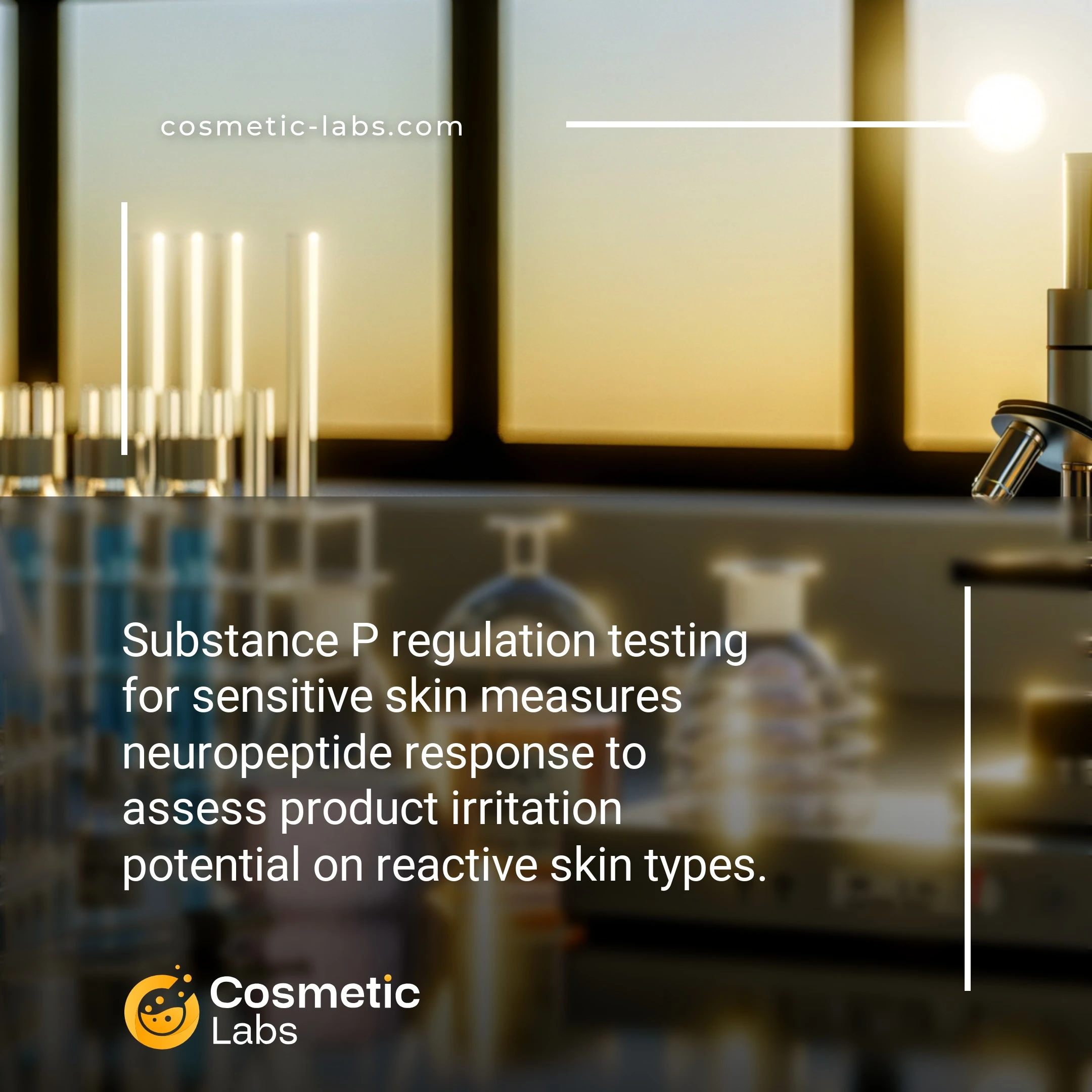Substance P Testing Services for Sensitive Skin Products

What is Substance P regulation?
Substance P regulation testing for sensitive skin measures how cosmetic formulations affect neurogenic inflammation pathways that trigger skin sensitivity reactions. Our partner labs use in vitro assays and reconstructed skin models to evaluate how ingredients modulate Substance P release from sensory nerve endings, helping you identify formulations that won’t cause stinging, burning, or irritation in sensitive skin types before clinical trials.
Why do you need this service?
Cosmetic labs use Substance P regulation testing to validate anti-irritation claims for sensitive skin products, measuring neurogenic inflammation responses in formulations containing calming ingredients like niacinamide or ceramides. This testing approach helps brands demonstrate clinically-backed soothing efficacy for product marketing while ensuring regulatory compliance for sensitive skin claims across global markets.
Who provides Substance P regulation services?
All cosmetic labs providing Substance P regulation services
There is no company providing these services at the moment.
Substance P Inhibition Testing for Sensitive Skin Formulations
Substance P inhibition testing measures how effectively cosmetic ingredients calm neurogenic inflammation in sensitive skin conditions. Labs use this biomarker assessment to validate anti-irritation claims and optimize formulations for reactive skin types.
Neurogenic Inflammation Pathway Analysis
Substance P acts as a key neurotransmitter that triggers inflammatory responses when skin encounters irritants. Testing protocols measure baseline Substance P release in cultured keratinocytes, then evaluate how candidate ingredients suppress this pathway. Labs typically run 24-48 hour exposure studies using standardized irritant challenges.
The process involves:
- Baseline Substance P quantification via ELISA immunoassays
- Ingredient dose-response testing at 0.1-10% concentrations
- Statistical analysis of inhibition percentages compared to controls
Clinical Translation and Formulation Guidance
Results from Substance P studies directly inform product positioning and ingredient selection for sensitive skin lines. Labs correlate in vitro inhibition data with human patch testing outcomes to establish predictive thresholds. Ingredients showing 30%+ Substance P reduction typically translate to measurable comfort improvements in clinical trials.
Testing services help brands identify optimal concentrations for calming actives like niacinamide, ceramides, and botanical extracts. Labs provide detailed reports linking molecular mechanisms to consumer-relevant benefits, supporting regulatory submissions and marketing claims.
Connect with specialized labs on our platform to discuss Substance P testing protocols tailored to your sensitive skin product development needs.
Practical Applications of Substance P Regulation Testing for Sensitive Skin
Beauty brands rely on Substance P regulation testing for sensitive skin to validate product safety and efficacy claims before market launch.
Anti-Inflammatory Product Development
Cosmetic labs measure Substance P levels in skin models to evaluate how formulations reduce neurogenic inflammation. This neuropeptide triggers irritation responses when released from sensory nerve endings. Testing protocols expose reconstructed skin tissues to potential irritants, then measure Substance P release using ELISA assays.
Labs typically run 48-72 hour exposure studies with concentration ranges from 0.1% to 5% of active ingredients. Results help brands optimize formulations for calming serums, sensitive skin cleansers, and post-procedure treatments. Data from these studies supports marketing claims about reduced skin reactivity and improved comfort.
Barrier Function Enhancement Validation
Product developers use Substance P regulation testing to prove their formulations strengthen skin’s natural defense mechanisms. When barrier function improves, sensory neurons release less Substance P in response to environmental stressors. Labs combine this testing with transepidermal water loss measurements and cytokine analysis.
Testing protocols include pre-treatment with candidate products followed by controlled stress exposure. Labs measure baseline Substance P levels, apply treatments for 7-14 days, then reassess neuropeptide release. Successful formulations show 20-40% reduction in Substance P compared to untreated controls.
| Testing Phase | Duration | Key Measurements | Success Criteria |
|---|---|---|---|
| Baseline Assessment | 24 hours | Substance P levels, skin pH | Stable readings |
| Product Application | 7-14 days | Daily monitoring | No adverse reactions |
| Stress Challenge | 48 hours | Substance P release, inflammation markers | ≥20% reduction vs control |
| Recovery Phase | 72 hours | Return to baseline | Normal function restored |
Ready to validate your sensitive skin formulations? Connect with experienced cosmetic labs on our platform to discuss Substance P regulation testing protocols tailored to your product development needs.
